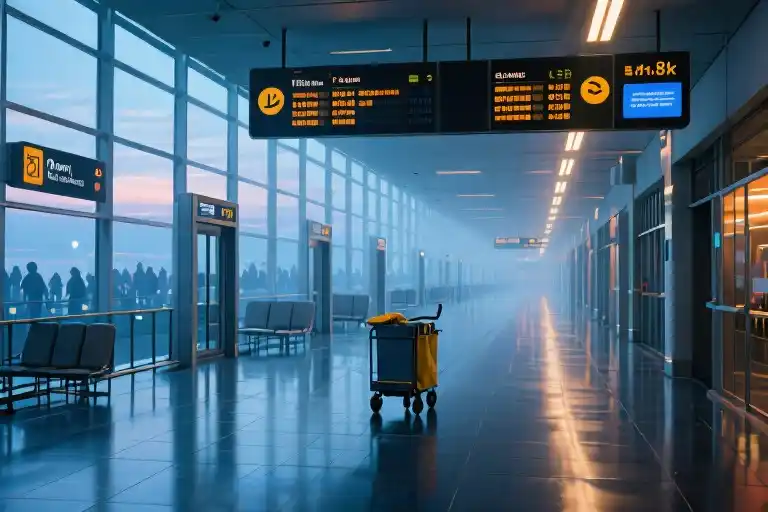The fluorescent lights hum a sterile lullaby at 3:47 AM, their glow reflecting off polished floors still damp with the sharp scent of disinfectant. Somewhere in the distance, a lone suitcase wheel squeaks in irregular intervals—the heartbeat of this transitional space. I rub my temples, caught between the adrenaline of wakefulness and the gravitational pull of sleep deprivation, my carefully planned itinerary already unraveling at the edges.
This wasn’t supposed to be my awakening hour. Yet here we are—me, the bleary-eyed barista resetting the espresso machine, the security guard stifling a yawn behind his mask, and three hundred other temporary residents of this liminal space. Our collective exhaustion hangs in the air like the faint metallic tang of recycled oxygen, each of us suspended between departure boards flickering with delayed notifications.
My fingers trace the crumpled boarding pass in my pocket. Flight 227: delayed indefinitely. The digital clock above Gate B12 blinks mockingly, its red digits cutting through the predawn gloom. Somewhere beyond the floor-to-ceiling windows, the first hint of daylight hesitates at the horizon—a visual representation of this peculiar stasis we’re all experiencing.
A child’s sudden laughter rings out near the charging stations, incongruously bright against the muted atmosphere. I watch as her tiny hands press against the glass, leaving smudged fingerprints on the pristine surface. For her, this unexpected pause is an adventure; for the businessman angrily typing nearby, it’s a cascading series of missed connections. The duality of airport limbo reveals itself in these contrasts—what’s merely inconvenient for some becomes life-altering for others.
The scent of burnt toast drifts from a nearby cafe, triggering an unexpected memory. Last Tuesday’s breakfast disaster—charred bread leading to a delayed departure that somehow allowed me to avoid a freeway pileup. The Burnt Toast Theory in action. As I inhale that familiar acrid aroma mingling with coffee grounds and synthetic lemon cleaner, the irony isn’t lost on me. Perhaps this very delay, this deviation from plans, will later reveal itself as protection rather than inconvenience.
A boarding announcement crackles through the speakers, static obscuring the destination. Around me, people stir like sleepwalkers—checking phones, adjusting neck pillows, performing the universal airport ballet of hope and resignation. In this threshold between night and morning, between plans and reality, we’re all participants in an unscripted experiment about redirection. The universe whispers through missed connections and rescheduled flights, if only we pause long enough to listen.
My meditation app remains unopened. Instead, I practice a different kind of mindfulness—eyes wide open, absorbing every detail of this accidental moment. The way the cleaning crew’s yellow vests reflect the emergency exit signs. How the vending machine’s blue display makes everyone’s skin look slightly alien. The rhythmic tapping of a student’s pencil against her physics textbook. These are my mantras now, anchoring me to the present in ways no guided audio ever could.
Somewhere beyond the security checkpoint, a suitcase topples over with a thud. A dozen heads turn instinctively, then return to their private dramas. We’re all protagonists in our own stories, extras in everyone else’s. The beauty of liminal spaces lies precisely in this—we’re given permission to simply exist, without the pressure of arrival or departure. Just beings in transit, momentarily freed from labels and expectations.
The smell of burnt toast lingers.
The Liminal Laboratory
The fluorescent lights of the 3AM terminal hum with a peculiar energy—not quite day, not quite night. This is the liminal space where normal rules dissolve, where we exist in life’s loading screen between chapters. From a psychological perspective, liminality represents those transitional phases when we’ve left one identity but haven’t yet assumed the next. Architecturally, airports physically manifest this concept through their purpose-built transience—nowhere here is designed for permanence.
At this hour, the usual airport rhythms stutter. The coffee stands with their steel shutters drawn become modern monoliths. Boarding calls echo through near-empty concourses like unanswered questions. Without the daytime crowds to perform for, people reveal their raw edges—a businessman sleeps mouth agape against a charging station, a student’s highlighters bleed through her notebook as she nods off. The social scripts we normally follow have been temporarily suspended.
Video games provide the perfect metaphor: we’re all avatars in this loading screen, progress bars hovering invisibly above our heads. The luggage carts glide like NPCs through predawn gloom. Every delayed passenger becomes a living embodiment of buffering—caught between the life they left and the one awaiting them. There’s unexpected freedom in this suspension; with conventional timekeeping meaningless, 4:17AM feels as plausible as noon.
What makes the overnight airport uniquely liminal compared to its daytime counterpart? Daylight exposes the machinery of travel—the stressed families, the overpriced sandwiches, the performative busyness of frequent flyers. But here in the blue-hour terminal, we see travel’s essence stripped bare. The departures board flickers with equal measures of hope and resignation. A janitor’s cart squeaks past gate B12 where three strangers share phone chargers without speaking. These aren’t disruptions to normal airport functioning—they are its truest function.
We become temporal squatters in this space between timelines. The Starbucks barista who’ll arrive in two hours doesn’t yet know the woman currently repacking her carry-on for the third time. The pilot sleeping at a nearby hotel hasn’t yet met the toddler who’ll press her nose against his cockpit window. All these potential connections hover in quantum superposition until the morning shift begins collapsing possibilities into reality.
Perhaps this is why liminal spaces haunt our collective imagination—they force us to sit with life’s unfinished sentences. Like a video game stuck at 99% loading, we itch to skip past this uncertainty. But what if we leaned in? What if we treated these suspended moments not as obstacles but as secret levels where unexpected power-ups might appear? The businessman wakes with a creased neck but clearer priorities. The student’s smudged notes contain her best idea yet. Sometimes the loading screen isn’t preventing the game—it’s part of the gameplay.
The Human Observatory
At 3:47 AM, the fluorescent lights hum louder than the passengers. Three distinct silhouettes emerge from the vinyl seats’ geometric patterns, each carrying invisible itineraries heavier than their carry-ons.
The Relocation Architects
A couple in their late sixties perch near Gate B12, their suitcase plastered with frayed baggage tags from Oslo to Brisbane. The husband absently rotates his wedding band while his wife traces airport codes on her phone – VCE, AMS, JFK – like reciting a rosary. Their possessions distilled into two checked bags and a shared anxiety about whether the retirement community in Portugal will have good oatmeal. Liminal space isn’t just physical for them; it’s the gulf between ‘who we were’ and ‘who we’ll become when the moving van empties.’
The Red-Eye Warriors
Twenty feet away, a man in a rumpled dress shirt constructs Excel formulas beneath the glow of a dying laptop battery. His loosened tie resembles a noose undone at the last moment. The flight delay notification flashing on his screen mirrors the one his wife received when he missed their anniversary dinner last month. Here in this transitional space, he exists between corporate expectations and personal failures, the airport’s sterile air absorbing the scent of his third espresso.
The Gap Year Pilgrim
Near the charging stations, a girl with sun-bleached braids sleeps curled around her backpack. The undamaged boarding pass bracelet on her wrist suggests she’s just beginning her journey rather than returning. Her journal peeks from an unzipped pocket, its pages filled with phrases like ‘find myself’ and ‘authentic experience’ – the mantras of those who mistake geography for transformation. The vending machine’s glow turns her into a temporary installation: ‘Youth in Transit (2023, mixed media).’
The Universal Curve
What binds them isn’t the flight information displays or the scent of industrial cleaner, but the unconscious vulnerability of their postures. Three hundred heads tilt back at identical angles, exposing throats to the ceiling lights. In this suspended hour, social masks slip along with neck muscles. The businessman’s spreadsheet fails to conceal his exhaustion, the retiree’s itinerary can’t hide her doubt, the wanderer’s bravado doesn’t survive REM sleep. Airport chairs become confessionals where bodies testify to truths mouths won’t speak.
This is where liminal theory becomes tactile – not in academic journals but in the way a stranger’s yawn triggers your own, how shared inconvenience creates momentary kinship between people who’ll never meet again. The woman crying softly near Hudson News isn’t just processing a breakup; she’s demonstrating the airport’s peculiar alchemy that turns private grief into public poetry. These aren’t passengers but human constellations, each constellation containing multitudes of redirected lives.
Key Observations:
- The suitcase tags form a geographical autobiography
- Spreadsheet cells mirror the windows of corporate towers
- Unbroken wristbands symbolize uncharted journeys
- The angle of repose reveals universal vulnerability
As dawn leaks through terminal windows, these temporary residents will disperse to boarding gates, their brief intersection already fading like contrails. But for now, in this fluorescent limbo, they form an accidental exhibit: Homo sapiens in Transitus, a species forever between destinations.
The Burnt Toast Revelation
That faint smell of charred bread in the airport café wasn’t just a breakfast mishap—it was a cosmic wink. The Burnt Toast Theory, that peculiar idea where minor inconveniences might be life’s protective mechanisms, first gained academic traction in a 1989 Cognitive Science study on counterfactual thinking. Researchers found our brains constantly simulate alternative scenarios, creating invisible safety nets we rarely acknowledge.
Silicon Valley engineers later repackaged this wisdom as their “bug=feature” philosophy. When servers crashed during peak traffic, they’d joke: “Maybe we’re preventing a worse meltdown.” This wasn’t mere optimism—it was systems thinking applied to daily life. That delayed flight? It could be your system’s graceful degradation.
Parallel Universes in Terminal B
Quantum physics meets baggage claim in this mental model: among infinite parallel timelines, you’re experiencing the one where deviations serve you best. Consider this real case:
timeline
title How a 47-Minute Delay Saved a Life
06:15 : Planned departure
06:22 : Burnt toast smell at café
06:30 : Passenger stops to buy antacids
07:02 : Actual takeoff
07:12 : Avoided highway pileup
(original Uber route timing)The magic lies not in proving causality, but in the mental space this perspective creates. Like airport Wi-Fi that connects only when you stop desperately refreshing, peace comes from releasing the need to decode every deviation.
The Upgrade Mindset
Next time your plans combust like overdone breakfast:
- Trace the ripple (“What interactions did this change create?”)
- Spot the padding (Flight delays build buffer time we’d otherwise waste)
- Thank your future self (Who may someday reveal why this helped)
As the boarding call echoes, remember: life’s best routes often appear as detours in the moment. That’s not rationalization—it’s the first-class version of adaptability.
The Redirection Playbook
Airports have a peculiar way of revealing life’s hidden instruction manuals. That pre-dawn limbo between sleep and wakefulness, between departure and arrival, creates the perfect mental space for recalibration. Here are three practical tools I’ve distilled from those fluorescent-lit hours of observation, each designed to transform frustration into curiosity.
Tool 1: The 5% Possibility Drill
Next time your gate changes unexpectedly, try this exercise instead of sighing at the extra steps:
- Identify the irritation (e.g., “Gate B12 to Gate A7 means 12 more minutes of walking”)
- Brainstorm five alternate scenarios where this change might serve you:
- Might spot a better snack option en route
- Could overhear useful travel tips from passing crew
- The new gate area has charging stations yours lacked
- Walking prevents blood clots from long sitting
- Serendipitous encounter with someone meaningful
- Select the most plausible positive (even if only 5% likely)
- Proceed while holding that possibility lightly
This isn’t Pollyanna optimism—it’s cognitive flexibility training. That businessman angrily stomping to his new gate? He’s burning energy on certainty the universe never promised. The woman humming while she reroutes? She’s practicing mental agility.
Tool 2: Temporal Tagging
Delays become heavier when we label them “ruining my entire trip.” Try these precision labels instead:
- Scope: “This affects my morning, not my conference” (versus “everything’s doomed”)
- Duration: “A 90-minute hiccup in a 14-day journey”
- Control: “Weather delay (external/uncontrollable) vs. oversleeping (internal/controllable)”
Watch how the emotional weight shifts when you relabel that canceled connection from “disaster” to “temporary transport reorganization.” The family calmly building card towers at Gate 15? They’ve mastered temporal tagging.
Tool 3: The Decade Lens
When irritation bubbles up, project forward:
- Visualize your future self ten years from now
- Ask: “How will I remember this moment?”
- As catastrophic? Probably not
- As amusing anecdote? Quite likely
- As turning point? Possibly
- Notice what surfaces—often, the real sting isn’t the delay but our imagined judgment (“They’ll think I’m unreliable!”). The backpacker sleeping peacefully across three chairs? She’s either naturally gifted at this or too tired to care—both enviable states.
These tools work because they leverage airport liminality rather than resisting it. That burnt toast aroma wafting from the 24-hour diner? Consider it your reminder: sometimes optimal routes emerge from apparent wrong turns.
The Scent of Possibility
The faint aroma of burnt toast still lingers in my memory as I step off the plane, that peculiar scent having woven itself into the fabric of this journey. It’s strange how sensory details become bookmarks in our lives – this charred fragrance now permanently associated with liminal spaces and redirected destinies.
An Olfactory Epilogue
That accidental breakfast smell served as my unexpected meditation bell throughout the airport experience. Each time it wafted through the terminal – whether from an overworked café toaster or some traveler’s abandoned snack – it pulled me back to the present moment. The Burnt Toast Theory manifested not just as philosophy but as literal scent markers along this transitional journey.
The Alternate Boarding Call
“Are you ready to board destiny’s standby flight?” This question isn’t about passive acceptance, but about developing what frequent flyers might call ‘situational awareness’ – that keen perception of alternative routes when Plan A collapses. The businessman who missed his connection might discover the airport bar serves exceptional single malt. The student delayed overnight could find herself sharing stories with a future mentor. These aren’t consolation prizes, but unplanned upgrades.
Five-Minute Gate Meditation
Next time your flight gets delayed, try this exercise:
- Ground: Feel your feet against the terminal floor
- Observe: Notice three human details without judgment (a child’s laughter, a suitcase wheel’s squeak)
- Wonder: Ask “What if this timing is perfect?”
- Release: Imagine your frustration as boarding pass confetti
- Receive: Stay open for unexpected connections
This practice transforms wasted time into what Buddhist teacher Tara Brach calls “sacred pause” – those involuntary stops that allow for course correction. The airport becomes less a purgatory and more a whispering gallery of potential pathways.
As the baggage carousel circles with its own hypnotic rhythm, I realize journeys never truly end at arrivals. We carry forward these liminal lessons – the way my carry-on still smells faintly of coffee and possibility. Perhaps that’s the ultimate redirection: understanding that every terminal is really a threshold, and each delay contains its own departure time.





